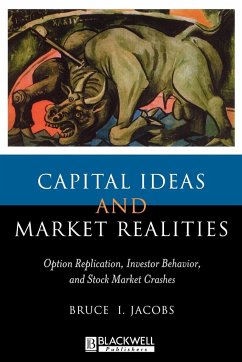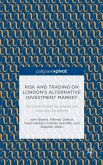The summer and fall of 1998 witnessed some of the most turbulent financial markets the world has ever seen. The implosion of the Russian financial markets and investors' ensuing flight to quality propelled the giant hedge-fund, long-term Capital Management, to the brink of collapse and left the investment portfolios of many of Wall Street's major banks and brokerage houses teetering on the brink. The US equity market dropped precipitously at the end of August and continued over the next month to experience levels of volatility not seen since the major crash of October 1987. Yet, within months of the August sell-off, US stocks had bounced back to new highs. How can markets fall so fast and recover so quickly? Bruce Jacobs sifts through the history of modern finance, from the efficient market hypothesis to behavioral psychology and chaos theory, to determine the cause of recent market crashes. He finds that some investment strategies, especially those based on theories that ignore the human element, can self-destruct, taking markets down with them. Ironically, some strategies that purport to reduce the risk of investing can pose the greater danger. Of particular concern is a trading strategy that grew out the option pricing model developed by the late Fisher Black and Nobel laureates Myron Scholes and Robert Merton. Used by market professionals, this strategy, known as option replication, requires mechanistic selling as stock prices decline and buying as stock prices rise. When a large enough number of investors engage in this type of trend-following "dynamic hedging", their trading demands can sweep markets along with them, elevating stock prices at some times and causing dramatic price drops at others. Dynamic hedging associated with some $100 billion in option-replication strategies caused a US stock market crash in 1987 that wiped out almost a quarter of US equity value and ignited market crashes around the world. Today, the same dynamic hedging underlies hundreds of billions of dollars in institutional and retail products. Capital Ideas and Market Realities uncovers the hidden risks these products pose for market stability and investor wealth. Visit the author's website at http: //www.cimrbook.com for further information.
"Wall Street's equivalent of the movie Nightmare on Elm Street -Part 10. Portfolio insurance / dynamic hedging, the FreddyKrueger of the 1987 stock market crash, is back again with therecent growth of options and swaps. Jacobs builds the case for howportfolio insurance and dynamic hedging exacerbated the 1987 crashand points out that dynamic hedging has played a similar role inrecent periods of market volatility." Robert Glauber, ExecutiveDirector, Brady Commission and former Under Secretary of theTreasury
"Bruce Jacobs, an investment manager who predicted before the1987 crash that portfolio insurance would trigger chain-reactionselling, recently forecast that option-strategies ('the sons ofportfolio insurance') would play a similar, though more muted, rolein a future debacle. Monday [October 27, 1997] provided damningevidence." The Wall Street Journal
"Every fiduciary should read this book. Investors have too oftenbeen taken in by promotions appealing to their basic humaninstincts of fear and greed. Bruce Jacobs shows how supposedlylow-risk, seemingly infallible, investment strategies can backfire.His views on portfolio insurance helped steer our profit-sharingfund away from that craze in 1987. Today, especially in light ofthe long-term Capital Management fiasco, investors should know whatBruce has to say about derivatives trading strategies and marketcrashes." John E. Stettler, Vice President - BenefitInvestments, Georgia-Pacific Corporation
"Bruce Jacobs demonstrates effectively that trend-followingstrategies like portfolio insurance are fair-weather techniquesthat may add to, rather than minimize, troubles when a major crashoccurs." Charles P. Kindleberger, author of Manias, Panics, andCrashes: A History of Financial Crisis
"Bruce Jacobs has created an instant classic. Capital Ideasand Market Realities demonstrates how products that appeal toinvestors' fears of short-term losses often ignore prudence andlong-term value. This book is a must read for every investor."The Journal of Investing
"Bruce Jacobs, an investment manager who predicted before the1987 crash that portfolio insurance would trigger chain-reactionselling, recently forecast that option-strategies ('the sons ofportfolio insurance') would play a similar, though more muted, rolein a future debacle. Monday [October 27, 1997] provided damningevidence." The Wall Street Journal
"Every fiduciary should read this book. Investors have too oftenbeen taken in by promotions appealing to their basic humaninstincts of fear and greed. Bruce Jacobs shows how supposedlylow-risk, seemingly infallible, investment strategies can backfire.His views on portfolio insurance helped steer our profit-sharingfund away from that craze in 1987. Today, especially in light ofthe long-term Capital Management fiasco, investors should know whatBruce has to say about derivatives trading strategies and marketcrashes." John E. Stettler, Vice President - BenefitInvestments, Georgia-Pacific Corporation
"Bruce Jacobs demonstrates effectively that trend-followingstrategies like portfolio insurance are fair-weather techniquesthat may add to, rather than minimize, troubles when a major crashoccurs." Charles P. Kindleberger, author of Manias, Panics, andCrashes: A History of Financial Crisis
"Bruce Jacobs has created an instant classic. Capital Ideasand Market Realities demonstrates how products that appeal toinvestors' fears of short-term losses often ignore prudence andlong-term value. This book is a must read for every investor."The Journal of Investing







